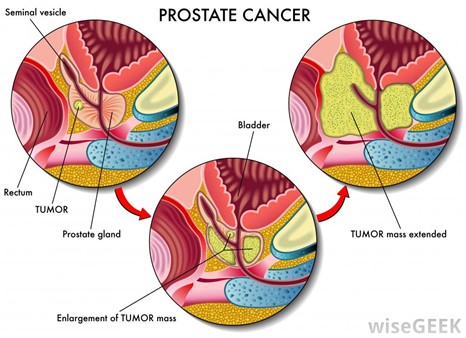Unfortunately, several cancers don’t cause symptoms recognized by the patient until they are either quite large or have spread throughout the body. Prostate cancer is like this:
- It is the most frequent cancer experienced by men,
- It is the second leading cause of cancer deaths in men.
The good news is that if it is identified and treated before it has spread beyond the prostate gland, many men can be cured. Also depending on the aggressiveness of the particular type of prostate cancer (determined by body scans for spread, and by microscopic analysis and genetic testing) even some non-cured cases spread so slowly as to allow a near normal life expectancy. Indeed, focal prostate cancer is commonly found during autopsy examination of men who died of other causes (e.g., heart attacks or strokes).
How to Test for Prostate Cancer
Prostate cancer becomes more common as men age, and since it initially causes no symptoms, needs to be screened for (similar to screening for breast cancer in women before it becomes grossly obvious).
Prostate-Specific Antigen Test
In addition to rectal examination in which the prostate can be felt and sometimes a suspicious lesion found (although not always), a commonly used screening is the prostate-specific antigen test which is usually elevated in the blood with prostate cancer. This test can also be somewhat elevated in other conditions such as infections involving the prostate or transiently after surgeries on the prostate for benign prostatic hypertrophy (see blog: “Benign Prostate Enlargement”). Thus, any positive blood test or suspicious from rectal examination needs to be followed by a study of an actual tissue sample of the prostate (a biopsy) and evaluated by a pathologist to confirm or disprove the diagnosis, and if positive, to grade the aggressiveness of the tumor. Measures of the aggressive behavior of the individual’s tumor are used to recommend the type of treatment for this cancer which may involve surgery to remove the prostate, radiation therapy, hormonal therapy, chemotherapy, or combinations of these treatments.
As an example, my older brother was totally asymptomatic, but on routine screening was found to have an elevated prostate-specific antigen level in his blood. This was followed by a minimally invasive biopsy which confirmed the diagnosis, and he was treated essentially with radiation therapy without evident occurrence or significant symptoms from the treatment. Unfortunately, years later, he died of an apparent heart attack, no relation to the prostate cancer.
Get Screened for Prostate Cancer Early
The bottom line is that all men over age 50 should at least be screened with the blood test. If this is positive, then they should be biopsied and further treatment (if required) developed from there. What you should NOT do is wait for symptoms such as blood in the urine, difficulty urinating, or erectile function problems, since these usually never occur before the cancer has spread and has become much less treatable. If you are over 50 years old, GET SCREENED as soon as you can! This literally may save your life and avoid all the problems with a spreading cancer.
For more information, see the American Cancer Society information on prostate cancer: https://www.cancer.org/cancer/prostate-cancer/about/what-is-prostate-cancer.html


